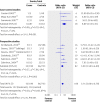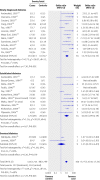Enterovirus infection and type 1 diabetes mellitus: systematic review and meta-analysis of observational molecular studies - PubMed (original) (raw)
Meta-Analysis
Enterovirus infection and type 1 diabetes mellitus: systematic review and meta-analysis of observational molecular studies
Wing-Chi G Yeung et al. BMJ. 2011.
Abstract
Objective: To review the association between current enterovirus infection diagnosed with molecular testing and development of autoimmunity or type 1 diabetes.
Design: Systematic review and meta-analysis of observational studies, analysed with random effects models.
Data sources: PubMed (until May 2010) and Embase (until May 2010), no language restrictions, studies in humans only; reference lists of identified articles; and contact with authors. Study eligibility criteria Cohort or case-control studies measuring enterovirus RNA or viral protein in blood, stool, or tissue of patients with pre-diabetes and diabetes, with adequate data to calculate an odds ratio and 95% confidence intervals.
Results: The 24 papers and two abstracts (all case-control studies) that met the eligibility criteria included 4448 participants. Study design varied greatly, with a high level of statistical heterogeneity. The two separate outcomes were diabetes related autoimmunity or type 1 diabetes. Meta-analysis showed a significant association between enterovirus infection and type 1 diabetes related autoimmunity (odds ratio 3.7, 95% confidence interval 2.1 to 6.8; heterogeneity χ(2)/df = 1.3) and clinical type 1 diabetes (9.8, 5.5 to 17.4; χ(2)/df = 3.2).
Conclusions: There is a clinically significant association between enterovirus infection, detected with molecular methods, and autoimmunity/type 1 diabetes. Larger prospective studies would be needed to establish a clear temporal relation between enterovirus infection and the development of autoimmunity and type 1 diabetes.
Conflict of interest statement
Competing interests: All authors have completed the Unified Competing Interest form at www.icmje.org/coi\_disclosure.pdf (available on request from the corresponding author) and declare: no support from any organisation for the submitted work; no financial relationships with any organisations that might have an interest in the submitted work in the previous 3 years; no other relationships or activities that could appear to have influenced the submitted work.
Figures
Fig 1 Odds ratios for enterovirus positivity in patients with pre-diabetes versus no diabetes
Fig 2 Odds ratios for enterovirus positivity in patients with and without diabetes
Comment in
- Enteroviruses and type 1 diabetes.
Hober D, Sane F. Hober D, et al. BMJ. 2011 Feb 3;342:c7072. doi: 10.1136/bmj.c7072. BMJ. 2011. PMID: 21292717 No abstract available.
Similar articles
- Maternal virus infections in pregnancy and type 1 diabetes in their offspring: Systematic review and meta-analysis of observational studies.
Allen DW, Kim KW, Rawlinson WD, Craig ME. Allen DW, et al. Rev Med Virol. 2018 May;28(3):e1974. doi: 10.1002/rmv.1974. Epub 2018 Mar 22. Rev Med Virol. 2018. PMID: 29569297 - Effects of a gluten-reduced or gluten-free diet for the primary prevention of cardiovascular disease.
Schmucker C, Eisele-Metzger A, Meerpohl JJ, Lehane C, Kuellenberg de Gaudry D, Lohner S, Schwingshackl L. Schmucker C, et al. Cochrane Database Syst Rev. 2022 Feb 24;2(2):CD013556. doi: 10.1002/14651858.CD013556.pub2. Cochrane Database Syst Rev. 2022. PMID: 35199850 Free PMC article. - Antibody tests for identification of current and past infection with SARS-CoV-2.
Fox T, Geppert J, Dinnes J, Scandrett K, Bigio J, Sulis G, Hettiarachchi D, Mathangasinghe Y, Weeratunga P, Wickramasinghe D, Bergman H, Buckley BS, Probyn K, Sguassero Y, Davenport C, Cunningham J, Dittrich S, Emperador D, Hooft L, Leeflang MM, McInnes MD, Spijker R, Struyf T, Van den Bruel A, Verbakel JY, Takwoingi Y, Taylor-Phillips S, Deeks JJ; Cochrane COVID-19 Diagnostic Test Accuracy Group. Fox T, et al. Cochrane Database Syst Rev. 2022 Nov 17;11(11):CD013652. doi: 10.1002/14651858.CD013652.pub2. Cochrane Database Syst Rev. 2022. PMID: 36394900 Free PMC article. - Intracavity lavage and wound irrigation for prevention of surgical site infection.
Norman G, Atkinson RA, Smith TA, Rowlands C, Rithalia AD, Crosbie EJ, Dumville JC. Norman G, et al. Cochrane Database Syst Rev. 2017 Oct 30;10(10):CD012234. doi: 10.1002/14651858.CD012234.pub2. Cochrane Database Syst Rev. 2017. PMID: 29083473 Free PMC article. - Different insulin types and regimens for pregnant women with pre-existing diabetes.
O'Neill SM, Kenny LC, Khashan AS, West HM, Smyth RM, Kearney PM. O'Neill SM, et al. Cochrane Database Syst Rev. 2017 Feb 3;2(2):CD011880. doi: 10.1002/14651858.CD011880.pub2. Cochrane Database Syst Rev. 2017. PMID: 28156005 Free PMC article.
Cited by
- A Rare Presentation of Hand, Foot, and Mouth Disease During Pregnancy.
Alam MR, Rokaya N, Mahat S, Upadhyaya A, Rokaya P. Alam MR, et al. Cureus. 2022 Aug 25;14(8):e28401. doi: 10.7759/cureus.28401. eCollection 2022 Aug. Cureus. 2022. PMID: 36043199 Free PMC article. - Enterovirus and type 1 diabetes: What is the matter?
Bergamin CS, Dib SA. Bergamin CS, et al. World J Diabetes. 2015 Jun 25;6(6):828-39. doi: 10.4239/wjd.v6.i6.828. World J Diabetes. 2015. PMID: 26131324 Free PMC article. Review. - No evidence of enteroviruses in the intestine of patients with type 1 diabetes.
Mercalli A, Lampasona V, Klingel K, Albarello L, Lombardoni C, Ekström J, Sordi V, Bolla A, Mariani A, Bzhalava D, Dillner J, Roivainen M, Bosi E, Piemonti L. Mercalli A, et al. Diabetologia. 2012 Sep;55(9):2479-88. doi: 10.1007/s00125-012-2591-4. Epub 2012 Jun 10. Diabetologia. 2012. PMID: 22684312 - Amplification and next generation sequencing of near full-length human enteroviruses for identification and characterisation from clinical samples.
Isaacs SR, Kim KW, Cheng JX, Bull RA, Stelzer-Braid S, Luciani F, Rawlinson WD, Craig ME. Isaacs SR, et al. Sci Rep. 2018 Aug 8;8(1):11889. doi: 10.1038/s41598-018-30322-y. Sci Rep. 2018. PMID: 30089864 Free PMC article.
References
- Hober D, Sauter P. Pathogenesis of type 1 diabetes mellitus: interplay between enterovirus and host. Nat Rev Endocrinol 2010;6:279-89. - PubMed
- Diamond PG. Incidence and trends of childhood type 1 diabetes worldwide 1990-1999. Diabet Med 2006;23:857-66. - PubMed
- EURODIAB. Variation and trends in incidence of childhood diabetes in Europe. Lancet 2000;355:873-6. - PubMed
- Patterson C, Dahlquist G, Gyürüs E, Green A, Soltész G. Incidence trends for childhood type 1 diabetes in Europe during 1989-2003 and predicted new cases 2005-20: a multicentre prospective registration study. Lancet 2009;373:2027-33. - PubMed
- Chong J, Craig M, Cameron F, Clarke C, Rodda C, Donath S, et al. Marked increase in type 1 diabetes mellitus incidence in children aged 0-14 yrs in Victoria, Australia, from 1999 to 2002. Pediatr Diabetes 2007;8:67-73. - PubMed
Publication types
MeSH terms
Substances
LinkOut - more resources
Full Text Sources
Other Literature Sources
Medical
Miscellaneous

